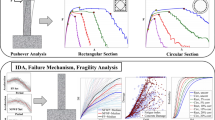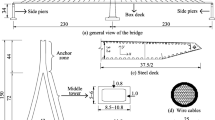Abstract
The objective of this study is to characterize the potential damage of near-fault ground motions on reinforced concrete bridge piers, providing information for engineering practice. To achieve this objective, 200 real near-fault pulse-type records and a bridge pier were selected. The same number of real far-fault ground motions was also selected for comparison. Inelastic time history and damage analyses were performed for the pier subjected to the selected near-fault and far-fault ground motions. The obtained results showed that more than 91% near-fault motions caused the pier to collapse while the pier survived under almost all far-fault motions. The responses of the pier under near-fault motions were characterized by one or few large hysteretic cycles. The damage indices of the pier subjected to near-fault ground motions increased rapidly when the pier underwent pulses of near-fault motions, and the pier damage was mainly caused by pulses. Collapse of the pier subjected to near-fault motions occurred at the pulse time. The duration to collapse, which was defined as the duration from light damage to collapse, of the pier under near-fault motions was extremely short (approximately 2.3–2.5 s). These special and negative structural damage characteristics of near-fault ground motions should be considered in designing and mitigating seismic hazards for structures located in near-fault regions.



















Similar content being viewed by others
References
Mavroeidis G, Papageorgiou A (2003) A mathematical representation of near-fault ground motions. Bull Seismol Soc Am 93(3):1099–1131
Bertero VV, Mahin SA, Herrera RA (1978) Aseismic design implications of near-fault San Fernando earthquake records. Earthq Eng Struct Dyn 6(1):31–42
Elnashai A, Sarno LD (2008) Fundamentals of earthquake engineering. Wiley, Oxford
Moustafa A, Takewaki I (2012) Characterization of earthquake ground motion of multiple sequences. Earthq Struct 3(5):629–647
Moustafa A, Takewaki I (2010) Characterization and modeling of near-fault pulse-like strong ground motion via damage-based critical excitation method. Struct Eng Mech 34(6):755–778. https://doi.org/10.12989/sem.2010.34.6.755
Kalkan E, Kunnath SK (2006) Effects of fling step and forward directivity on seismic response of buildings. Earthq Spect 22(2):367–390
Lu L-Y, Lin G-L (2009) Improvement of near-fault seismic isolation using a resettable variable stiffness damper. Eng Struct 31:2097–2114
Hatzigeorgiou GD (2010) Behavior factors for nonlinear structures subjected to multiple near-fault earthquakes. Comput Struct 88:309–321
Park SW, Ghasemi H, Shen J, Somerville PG, Yen WP, Yashinsky M (2004) Simulation of the seismic performance of the Bolu Viaduct subjected to near-fault ground motions. Earthq Eng Struct Dyn 33:1249–1270
Galal K, Ghobarah A (2006) Effect of near-fault earthquakes on North American nuclear design spectra. Nucl Eng Des 236:1928–1936
Baker JW (2007) Quantitative classification of near-fault ground motions using wavelet analysis. Bull Seismol Soc Am 97(5):1486–1501
Galal K, Naimi M (2008) Effect of soil conditions on the response of reinforced concrete tall structures to near fault earthquakes. Struct Des Tall Spec Build 17:541–562
Mollaioli F, Bruno S, Decanini LD, Panza GF (2006) Characterization of the dynamic response of structures to damaging pulse-type near-fault ground motions. Meccanica 41:23–46
Krishnan S (2007) Case studies of damage to 19-storey irregular steel moment-frame buildings under near-source ground motion. Earthq Eng Struct Dyn 36:861–885
Chopra AK, Chintanapakdee C (2001) Comparing response of SDF systems to near-fault and far-fault earthquake motions in the context of spectral regions. Earthq Eng Struct Dyn 30:1769–1789
Manfredi G, Polese M, Cosenza E (2003) Cumulative demand of the earthquake ground motions in the near source. Earthq Eng Struct Dyn 32:1853–1865
Ghahari SF, Jahankhah H, Ghannad MA (2010) Study on elastic response of structures to near-fault ground motions through record decomposition. Soil Dyn Earthq Eng 30:536–546
Hatzigeorgiou GD (2010) Ductility demand spectra for multiple near- and far- fault earthquakes. Soil Dyn Earthq Eng 30:170–183
Rupakhety R, Sigurdsson SU, Papageorgiou AS, Sigbjörnsson R (2011) Quantification of ground-motion parameters and response spectra in the near-fault region. Bull Earthq Eng 9(4):893–930. https://doi.org/10.1007/s10518-011-9255-5
Garini E, Gazetas G (2013) Damage potential of near-fault records: sliding displacement against conventional “Intensity Measures”. Bull Earthq Eng 11(2):455–480. https://doi.org/10.1007/s10518-012-9397-0
Garini E, Makris N, Gazetas G (2015) Elastic and inelastic systems under near-fault seismic shaking: acceleration records versus optimally-fitted wavelets. Bull Earthq Eng 13(2):459–482. https://doi.org/10.1007/s10518-014-9631-z
Eskandari R, Vafaei D (2015) Effects of near-fault records characteristics on seismic performance of eccentrically braced frames. Struct Eng Mech 56(5):855–870
Dicleli M, Mehta A (2007) Effect of near-fault ground motion and damper characteristics on the seismic performance of chevron braced steel frames. Earthq Eng Struct Dyn 36:927–948
Jadhav MB, Jangid RS (2016) Response of base-isolated liquid storage tanks to near-fault motions. Struct Eng Mech 23(6):615–634
Choi I-K, Choun Y-S, Ahn S-M, Seo J-M (2008) Probabilistic seismic risk analysis of CANDU containment structure for near-fault earthquakes. Nucl Eng Des 238:1382–1391
Choi H, Saiidi MS, Somerville P, El-Azazy S (2010) Experimental study of reinforced concrete bridge columns subjected to near-fault ground motions. ACI Struct J 107(1):3–12
Tsai KC, Hsiao CP, Bruneau M (2000) Overview of building damages in 921 Chi-Chi earthquake. Earthq Eng Eng Seismol 2(1):93–108
Cao VV, Ronagh HR, Baji H (2014) Seismic risk assessment of deficient reinforced concrete frames in near-fault regions. Adv Concrete Constr 2(4):261–280. https://doi.org/10.12989/acc.2014.2.4.261
Liao W-I, Loh C-H, Wan S (2001) Earthquake responses of RC moment frames subjected to near-fault ground motions. Struct Des Tall Spec Build 10:219–229
Dolati A, Taghikhany T, Khanmohammadi M, Rahai A (2015) Scenario-based seismic performance assessment of regular and irregular highway bridges under near-fault ground motions. Earthq Struct 8(3):573–589. https://doi.org/10.12989/eas.2015.8.3.573
Yüksel E, Sürmeli M (2010) Failure analysis of one-story precast structures for near-fault and far-fault strong ground motions. Bull Earthq Eng 8:937–953
Park Y-J, Ang AH-S (1985) Mechanistic seismic damage model for reinforced concrete. J Struct Eng 111(4):722–739
Mazza F, Vulcano A (2010) Nonlinear dynamic response of r.c. framed structures subjected to near-fault ground motions. Bull Earthq Eng 8(6):1331–1350. https://doi.org/10.1007/s10518-010-9180-z
Computers and Structures Inc (2017) SAP2000 version 19.2.0
Cao VV, Ronagh H, Ashraf M, Baji H (2014) A new damage index for reinforced concrete structures. Earthq Struct 6(6):581–609. https://doi.org/10.12989/eas.2014.6.6.581
PEER PEER ground motion database. https://ngawest2.berkeley.edu/site. Accessed 2018
Pantelides C, Gergely J (2002) Carbon-fiber-reinforced polymer seismic retrofit of RC bridge bent: design and in situ validation. J Compos Constr 6(1):52–60. https://doi.org/10.1061/(asce)1090-0268(2002)6:1(52)
Pantelides C, Reaveley L, Duffin J, Ward J, Delahunty C (2003) In-situ tests of three bents at South Temple bridge on Interstate 15—Final report (trans: Division UDoTR). Civil & Environmental Engineering Department, University of Utah, Salt Lake City
Pantelides C, Gergely J, Marriott N, Reavely L (2000) Seismic rehabilitation of concrete bridges: verification using in situ tests at South Temple bridge on Interstate 15 (trans: Division UDoTR). Vol Final Report. Department of Civil & Environmental Engineering, University of Utah, Salt Lake City
ACI (2008) Building code requirements for structural concrete (ACI 318 M-08) and commentary. American Concrete Institute, Farmington Hills
Takeda T, Sozen MA, Nielsen NN (1970) Reinforced concrete response to simulated earthquakes. J Struct Div 96:2557–2573
Sheikh SA, Khoury SS (1993) Confined concrete columns with stubs. ACI Struct J 90(4):414–431
Park R, Priestley MJN, Gill WD (1982) Ductility of square-confined concrete columns. J Struct Div 108:929–950
Kent DC, Park R (1971) Flexural members with confined concrete. J Struct Div 97(7):1969–1990
Paulay T, Priestley MJN (eds) (1992) Seismic design of reinforced concrete and masonry buildings. Wiley, New York
Priestley MJN (2000) Performance based seismic design. In: 12th world conference on earthquake engineering, Auckland, New Zealand
AASHTO (2012) AASHTO LRFD bridge design specifications. American Association of State Highway and Transportation Officials, Washington, DC, p 20001
Acknowledgements
This research is funded by Ho Chi Minh City University of Technology under Grant number T-KTXD-2018-44.
Author information
Authors and Affiliations
Corresponding author
Rights and permissions
About this article
Cite this article
Van Cao, V. Characterization of Near-Fault Effects on Potential Cumulative Damage of Reinforced Concrete Bridge Piers. Int J Civ Eng 17, 1603–1618 (2019). https://doi.org/10.1007/s40999-019-00428-z
Received:
Revised:
Accepted:
Published:
Issue Date:
DOI: https://doi.org/10.1007/s40999-019-00428-z




